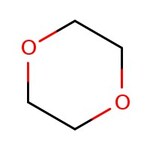Search Thermo Fisher Scientific
1,4-Dioxane, 99+%, stab. with ca 5-10ppm BHT, Thermo Scientific Chemicals



1,4-Dioxane, 99+%, stab. with ca 5-10ppm BHT, Thermo Scientific Chemicals
Chemical Identifiers
Specifications
Description
This Thermo Scientific Chemicals brand product was originally part of the Alfa Aesar product portfolio. Some documentation and label information may refer to the legacy brand. The original Alfa Aesar product / item code or SKU reference has not changed as a part of the brand transition to Thermo Scientific Chemicals.
1,4-Dioxane is used as a stabilizer for 1,1,1-trichloroethane and chlorinated solvents. It acts as a solvent for cellulose acetate, ethyl cellulose, benzyl cellulose, resins, oils, waxes, dyes, other organic and inorganic compounds. It acts as a substitute for tetrahydrofuran due to its higher boiling point and lower toxicity. Further, it is used as an internal standard for proton NMR spectroscopy in deuterium oxide. It plays an important role in liquid scintillation counting in biological procedures, and as a wetting and dispersing agent in textile processing. It is involved in the preparation of dimethylmagnesium by reacting with methylmagnesium bromide, and in the preparation of histological sections for microscopic examination.
Solubility
Miscible with water, organic solvents, aromatic hydrocarbons and oils.
Notes
Hygroscopic. Incompatible with oxygen, oxidizing agents, halogens, reducing agents, perchlorates and trimethylaluminum.
Figures
Documents & Downloads
Certificates
Frequently asked questions (FAQs)
Citations & References
Safety and Handling
Classification of the substance or mixture
CLP classification - Regulation(EC) No 1272/2008
Label Elements
Signal Word
Danger
Hazard Statements
H319 - Causes serious eye irritation
H335 - May cause respiratory irritation
H350 - May cause cancer
Physical Hazards
H225 - Highly flammable liquid and vapor
EU Specific Hazard Statements
EUH019 - May form explosive peroxides
EUH066 - Repeated exposure may cause skin dryness or cracking
Precautionary Statements
P210 - Keep away from heat, hot surfaces, sparks, open flames and other ignition sources. No smoking
P280 - Wear protective gloves/protective clothing/eye protection/face protection
P303 + P361 + P353 - IF ON SKIN (or hair): Take off immediately all contaminated clothing. Rinse skin with water or shower
P304 + P340 - IF INHALED: Remove person to fresh air and keep comfortable for breathing
P305 + P351 + P338 - IF IN EYES: Rinse cautiously with water for several minutes. Remove contact lenses, if present and easy to do. Continue rinsing
P312 - Call a POISON CENTER or doctor if you feel unwell
Additional EU labelling
Restricted to professional users